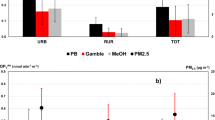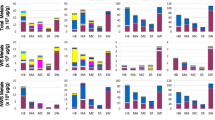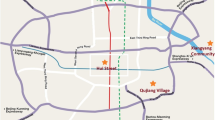Abstract
Filter-based toxicology studies are conducted to establish the biological plausibility of the well-established health impacts associated with fine particulate matter (PM2.5) exposure. Ambient PM2.5 collected on filters is extracted into solution for toxicology applications, but frequently, characterization is nonexistent or only performed on filter-based PM2.5, without consideration of compositional differences that occur during the extraction processes. To date, the impact of making associations to measured components in ambient instead of extracted PM2.5 has not been investigated. Filter-based PM2.5 was collected at locations (n = 5) and detailed characterization of both ambient and extracted PM2.5 was performed. Alveolar macrophages (AMJ2-C11) were exposed (3, 24, and 48 h) to PM2.5 and the pro-inflammatory cytokine interleukin (IL)-6 was measured. IL-6 release differed significantly between PM2.5 collected from different locations; surprisingly, IL-6 release was highest following treatment with PM2.5 from the lowest ambient concentration location. IL-6 was negatively correlated with the sum of ambient metals analyzed, as well as with concentrations of specific constituents which have been previously associated with respiratory health effects. However, positive correlations of IL-6 with extracted concentrations indicated that the negative associations between IL-6 and ambient concentrations do not accurately represent the relationship between inflammation and PM2.5 exposure. Additionally, seven organic compounds had significant associations with IL-6 release when considering ambient concentrations, but they were not detected in the extracted solution. Basing inflammatory associations on ambient concentrations that are not necessarily representative of in vitro exposures creates misleading results; this study highlights the importance of characterizing extraction solutions to conduct accurate health impact research.


Similar content being viewed by others

References
Abbey, D. E., Ostro, B. E., Petersen, F., & Burchette, R. J. (1995). Chronic respiratory symptoms associated with estimated long-term ambient concentrations of fine particulates less than 2.5 microns in aerodynamic diameter (PM2.5) and other air pollutants. Journal of exposure analysis and environmental epidemiology, 5(2), 137–159.
Akhtar, U. S., McWhinney, R. D., Rastogi, N., Abbatt, J. P., Evans, G. J., & Scott, J. A. (2010). Cytotoxic and proinflammatory effects of ambient and source-related particulate matter (PM) in relation to the production of reactive oxygen species (ROS) and cytokine adsorption by particles. Inhalation Toxicology, 22(Suppl 2), 37–47.
Akhtar, U. S., Ratstogi, N., McWhinney, R. D., Urch, B., Chow, C., Evans, G. J., & Scott, J. A. (2014). The combined effects of physicochemical properties of size-fractionated ambient particulate matter on in vitro toxicity in human A549 lung epithelial cells. Toxicology Reports, 1, 145–156.
Anderson, J. O., Thundiyil, J. G., & Stolbach, A. (2012). Clearing the air: a review of the effects of particulate matter air pollution on human health. Journal of medical toxicology : official journal of the American College of Medical Toxicology, 8(2), 166–175.
Araujo, J. A. (2010). Particulate air pollution, systemic oxidative stress, inflammation, and atherosclerosis. Air quality, Atmosphere, Health, 4(1), 79–93.
Becker, S., Mundandhara, S., Devlin, R. B., & Madden, M. (2005). Regulation of cytokine production in human alveolar macrophages and airway epithelial cells in response to ambient air pollution particles: further mechanistic studies. Toxicology and Applied Pharmacology, 207(2 Suppl), 269–275.
Becker, S., Soukup, J. M., Sioutas, C., & Cassee, F. R. (2003). Response of human alveolar macrophages to ultrafine, fine, and coarse urban air pollution particles. Experimental Lung Research, 29(1), 29–44.
Bein, K. J., & Wexler, A. S. (2014). A high-efficiency, low-bias method for extracting particulate matter from filter and impactor substrates. Atmospheric Environment, 90, 87–95.
Bernstein, J. A., Alexis, N., Barnes, C., Bernstein, I. L., Nel, A., Peden, D., Diaz-Sanchez, D., Tarlo, S. M., & Williams, P. B. (2004). Health effects of air pollution. The Journal of Allergy and Clinical Immunology, 114(5), 1116–1123.
Cavanagh, J. A., Trought, K., Brown, L., & Duggan, S. (2009). Exploratory investigation of the chemical characteristics and relative toxicity of ambient air particulates from two New Zealand cities. The Science of the Total Environment, 407(18), 5007–5018.
Choi, J. H., Kim, J. S., Kim, Y. C., Kim, Y. S., Chung, N. H., & Cho, M. H. (2004). Comparative study of PM2.5- and PM10-induced oxidative stress in rat lung epithelial cells. Journal of Veterinary Science, 5(1), 11–18.
Danielsen, P. H., Moller, P., Jensen, K. A., Sharma, A. K., Wallin, H., Bossi, R., Autrup, H., Molhave, L., Ravanat, J. L., Briede, J. J., de Kok, T. M., & Loft, S. (2011). Oxidative stress, DNA damage, and inflammation induced by ambient air and wood smoke particulate matter in human A549 and THP-1 cell lines. Chemical Research in Toxicology, 24(2), 168–184.
de Brito, K. C., de Lemos, C. T., Rocha, J. A., Mielli, A. C., Matzenbacher, C., & Vargas, V. M. (2013). Comparative genotoxicity of airborne particulate matter (PM2.5) using Salmonella, plants and mammalian cells. Ecotoxicology and Environmental Safety, 94, 14–20.
de Kok, T. M., Hogervorst, J. G., Briede, J. J., van Herwijnen, M. H., Maas, L. M., Moonen, E. J., Driece, H. A., & Kleinjans, J. C. (2005). Genotoxicity and physicochemical characteristics of traffic-related ambient particulate matter. Environmental and Molecular Mutagenesis, 46(2), 71–80.
Delfino, R. J., Staimer, N., Tjoa, T., Arhami, M., Polidori, A., Gillen, D. L., George, S. C., Shafer, M. M., Schauer, J. J., & Sioutas, C. (2010). Associations of primary and secondary organic aerosols with airway and systemic inflammation in an elderly panel cohort. Epidemiology, 21(6), 892–902.
Dellinger, B., Pryor, W. A., Cueto, R., Squadrito, G. L., Hegde, V., & Deutsch, W. A. (2001). Role of free radicals in the toxicity of airborne fine particulate matter. Chemical Research in Toxicology, 14(10), 1371–1377.
Deng, X., Rui, W., Zhang, F., & Ding, W. (2013). PM2.5 induces Nrf2-mediated defense mechanisms against oxidative stress by activating PIK3/AKT signaling pathway in human lung alveolar epithelial A549 cells. Cell Biology and Toxicology, 29(3), 143–157.
Dominici, F., Peng, R. D., Bell, M. L., Pham, L., McDermott, A., Zeger, S. L., & Samet, J. M. (2006). Fine particulate air pollution and hospital admission for cardiovascular and respiratory diseases. JAMA : the journal of the American Medical Association, 295(10), 1127–1134.
Gerlofs-Nijland, M. E., Dormans, J. A., Bloemen, H. J., Leseman, D. L., John, A., Boere, F., Kelly, F. J., Mudway, I. S., Jimenez, A. A., Donaldson, K., Guastadisegni, C., Janssen, N. A., Brunekreef, B., Sandstrom, T., van Bree, L., & Cassee, F. R. (2007). Toxicity of coarse and fine particulate matter from sites with contrasting traffic profiles. Inhalation Toxicology, 19(13), 1055–1069.
Godri, K. J., Harrison, R. M., Evans, T., Baker, T., Dunster, C., Mudway, I. S., & Kelly, F. J. (2011). Increased oxidative burden associated with traffic component of ambient particulate matter at roadside and urban background schools sites in London. PloS One, 6(7), e21961.
Gualtieri, M., Longhin, E., Mattioli, M., Mantecca, P., Tinaglia, V., Mangano, E., Proverbio, M. C., Bestetti, G., Camatini, M., & Battaglia, C. (2012). Gene expression profiling of A549 cells exposed to Milan PM2.5. Toxicology Letters, 209(2), 136–145.
Happo, M., Markkanen, A., Markkanen, P., Jalava, P., Kuuspalo, K., Leskinen, A., Sippula, O., Lehtinen, K., Jokiniemi, J., & Hirvonen, M. R. (2013). Seasonal variation in the toxicological properties of size-segregated indoor and outdoor air particulate matter. Toxicology in vitro : an international journal published in association with BIBRA, 27(5), 1550–1561.
Happo, M. S., Hirvonen, M. R., Halinen, A. I., Jalava, P. I., Pennanen, A. S., Sillanpaa, M., Hillamo, R., & Salonen, R. O. (2010). Seasonal variation in chemical composition of size-segregated urban air particles and the inflammatory activity in the mouse lung. Inhalation Toxicology, 22(1), 17–32.
Hetland, R. B., Cassee, F. R., Refsnes, M., Schwarze, P. E., Lag, M., Boere, A. J., & Dybing, E. (2004). Release of inflammatory cytokines, cell toxicity and apoptosis in epithelial lung cells after exposure to ambient air particles of different size fractions. Toxicology in vitro : an international journal published in association with BIBRA, 18(2), 203–212.
Huang, Q., Zhang, J., Peng, S., Tian, M., Chen, J., & Shen, H. (2014). Effects of water soluble PM2.5 extracts exposure on human lung epithelial cells (A549): a proteomic study. Journal of Applied Toxicology : JAT, 34(6), 675–687.
Huang, S. L., Hsu, M. K., & Chan, C. C. (2003). Effects of submicrometer particle compositions on cytokine production and lipid peroxidation of human bronchial epithelial cells. Environmental Health Perspectives, 111(4), 478–482.
Jalava, P. I., Hirvonen, M. R., Sillanpaa, M., Pennanen, A. S., Happo, M. S., Hillamo, R., Cassee, F. R., Gerlofs-Nijland, M., Borm, P. J., Schins, R. P., Janssen, N. A., & Salonen, R. O. (2009). Associations of urban air particulate composition with inflammatory and cytotoxic responses in RAW 246.7 cell line. Inhalation Toxicology, 21(12), 994–1006.
Jalava, P. I., Salonen, R. O., Halinen, A. I., Penttinen, P., Pennanen, A. S., Sillanpaa, M., Sandell, E., Hillamo, R., & Hirvonen, M. R. (2006). In vitro inflammatory and cytotoxic effects of size-segregated particulate samples collected during long-range transport of wildfire smoke to Helsinki. Toxicology and Applied Pharmacology, 215(3), 341–353.
Janssen, N. A., Yang, A., Strak, M., Steenhof, M., Hellack, B., Gerlofs-Nijland, M. E., Kuhlbusch, T., Kelly, F., Harrison, R., Brunekreef, B., Hoek, G., & Cassee, F. (2014). Oxidative potential of particulate matter collected at sites with different source characteristics. The Science of the Total Environment, 472, 572–581.
Jeong, S. C., Shin, C. Y., Song, M. K., Cho, Y., & Ryu, J. C. (2014). Gene expression profiling of human alveolar epithelial cells (A549 cells) exposed to atmospheric particulate matter 2.5 collected from Seoul, Korea. Molecular and Cellular Toxicology, 10, 361–368.
Kumar, R. K., Shadie, A. M., Bucknall, M. P., Rutlidge, H., Garthwaite, L., Herbert, C., Halliburton, B., Parsons, K. S., & Wark, P. A. (2015). Differential injurious effects of ambient and traffic-derived particulate matter on airway epithelial cells. Respirology, 20(1), 73–79.
Lauer, F. T., Mitchell, L. A., Bedrick, E., McDonald, J. D., Lee, W. Y., Li, W. W., Olvera, H., Amaya, M. A., Berwick, M., Gonzales, M., Currey, R., Pingitore, N. E., & Burchiel, S. W. (2009). Temporal-spatial analysis of US-Mexico border environmental fine and coarse PM air sample extract activity in human bronchial epithelial cells. Toxicology and Applied Pharmacology, 238(1), 1–10.
Mar, T. F., Norris, G. A., Koenig, J. Q., & Larson, T. V. (2000). Associations between air pollution and mortality in Phoenix, 1995–1997. Environmental Health Perspectives, 108(4), 347–353.
Mirowsky, J. E., Jin, L., Thurston, G., Lighthall, D., Tyner, T., Horton, L., Galdanes, K., Chillrud, S., Ross, J., Pinkerton, K. E., Chen, L. C., Lippmann, M., & Gordon, T. (2015). In vitro and in vivo toxicity of urban and rural particulate matter from California. Atmospheric Environment, 103, 256–262.
Mitschik, S., Schierl, R., Nowak, D., & Jorres, R. A. (2008). Effects of particulate matter on cytokine production in vitro: a comparative analysis of published studies. Inhalation Toxicology, 20(4), 399–414.
Ostro, B., Feng, W. Y., Broadwin, R., Green, S., & Lipsett, M. (2007). The effects of components of fine particulate air pollution on mortality in California: results from CALFINE. Environmental Health Perspectives, 115(1), 13–19.
Ostro, B., Lipsett, M., Reynolds, P., Goldberg, D., Hertz, A., Garcia, C., Henderson, K. D., & Bernstein, L. (2010). Long-term exposure to constituents of fine particulate air pollution and mortality: results from the California Teachers Study. Environmental Health Perspectives, 118(3), 363–369.
Ostro, B., Roth, L., Malig, B., & Marty, M. (2009). The effects of fine particle components on respiratory hospital admissions in children. Environmental Health Perspectives, 117(3), 475–480.
Perrone, M. G., Gualtieri, M., Ferrero, L., Lo Porto, C., Udisti, R., Bolzacchini, E., & Camatini, M. (2010). Seasonal variations in chemical composition and in vitro biological effects of fine PM from Milan. Chemosphere, 78(11), 1368–1377.
Riva, D. R., Magalhaes, C. B., Lopes, A. A., Lancas, T., Mauad, T., Malm, O., Valenca, S. S., Saldiva, P. H., Faffe, D. S., & Zin, W. A. (2011). Low dose of fine particulate matter (PM2.5) can induce acute oxidative stress, inflammation and pulmonary impairment in healthy mice. Inhalation Toxicology, 23(5), 257–267.
Roper, C., Chubb, L. G., Cambal, L., Tunno, B., Clougherty, J. E., & Mischler, S. E. (2015). Characterization of ambient and extracted PM2.5 collected on filters for toxicology applications. Inhalation Toxicology, 27, 673–681.
Ruckerl, R., Ibald-Mulli, A., Koenig, W., Schneider, A., Woelke, G., Cyrys, J., Heinrich, J., Marder, V., Frampton, M., Wichmann, H. E., & Peters, A. (2006). Air pollution and markers of inflammation and coagulation in patients with coronary heart disease. American Journal of Respiratory and Critical Care Medicine, 173(4), 432–441.
Sawyer, K., Mundandhara, S., Ghio, A. J., & Madden, M. C. (2010). The effects of ambient particulate matter on human alveolar macrophage oxidative and inflammatory responses. Journal of Toxicology and Environmental Health Part A, 73(1), 41–57.
Schaumann, F., Borm, P. J., Herbrich, A., Knoch, J., Pitz, M., Schins, R. P., Luettig, B., Hohlfeld, J. M., Heinrich, J., & Krug, N. (2004). Metal-rich ambient particles (particulate matter 2.5) cause airway inflammation in healthy subjects. American Journal of Respiratory and Critical Care Medicine, 170(8), 898–903.
Schins, R., Knaapen, A., Weishaupt, C., Winzer, A., & Borm, P. (2002). Cytotoxic and inflammatory effects of coarse and fine particulate matter in macrophages and epithelial cells. The Annals of Occupational Hygiene, 46, 203–206.
Schwarze, P. E., Ovrevik, J., Lag, M., Refsnes, M., Nafstad, P., Hetland, R. B., & Dybing, E. (2006). Particulate matter properties and health effects: consistency of epidemiological and toxicological studies. Human & Experimental Toxicology, 25(10), 559–579.
Shang, Y., Fan, L., Feng, J., Lv, S., Wu, M., Li, B., & Zang, Y. S. (2013). Genotoxic and inflammatory effects of organic extracts from traffic-related particulate matter in human lung epithelial A549 cells: the role of quinones. Toxicology In Vitro : an international journal published in association with BIBRA, 27(2), 922–931.
Skarek, M., Janosek, J., Cupr, P., Kohoutek, J., Novotna-Rychetska, A., & Holoubek, I. (2007). Evaluation of genotoxic and non-genotoxic effects of organic air pollution using in vitro bioassays. Environment International, 33(7), 859–866.
Tager, I. B., Lurmann, F. W., Haight, T., Alcorn, S., Penfold, B., & Hammond, S. K. (2010). Temporal and spatial patterns of ambient endotoxin concentrations in Fresno, California. Environmental Health Perspectives, 118(10), 1490–1496.
Tecer, L. H., Alagha, O., Karaca, F., Tuncel, G., & Eldes, N. (2008). Particulate matter (PM(2.5), PM(10–2.5), and PM(10)) and children’s hospital admissions for asthma and respiratory diseases: a bidirectional case-crossover study. Journal of toxicology and environmental health Part A, 71(8), 512–520.
Topinka, J., Rossner, P., Jr., Milcova, A., Schmuczerova, J., Svecova, V., & Sram, R. J. (2011). DNA adducts and oxidative DNA damage induced by organic extracts from PM2.5 in an acellular assay. Toxicology Letters, 202(3), 186–192.
Valavanidis, A., Vlahoyianni, T., & Fiotakis, K. (2005). Comparative study of the formation of oxidative damage marker 8-hydroxy-2′-deoxyguanosine (8-OHdG) adduct from the nucleoside 2′-deoxyguanosine by transition metals and suspensions of particulate matter in relation to metal content and redox reactivity. Free Radical Research, 39(10), 1071–1081.
Van Winkle, L. S., Bein, K., Anderson, D., Pinkerton, K. E., Tablin, F., Wilson, D., & Wexler, A. S. (2015). Biological dose response to PM2.5: effect of particle extraction method on platelet and lung responses. Toxicological Sciences : an official journal of the Society of Toxicology, 143(2), 349–359.
Verma, V., Rico-Martinez, R., Kotra, N., King, L., Liu, J., Snell, T. W., & Weber, R. J. (2012). Contribution of water-soluble and insoluble components and their hydrophobic/hydrophilic subfractions to the reactive oxygen species-generating potential of fine ambient aerosols. Environmental Science & Technology, 46(20), 11384–11392.
Villeneuve, P. J., Weichenthal, S. A., Crouse, D., Miller, A. B., To, T., Martin, R. V., van Donkelaar, A., Wall, C., & Burnett, R. T. (2015). Long-term exposure to fine particulate matter air pollution and mortality among Canadian women. Epidemiology, 26(4), 536–545.
Wang, W., Jariyasopit, N., Schrlau, J., Jia, Y., Tao, S., Yu, T. W., Dashwood, R. H., Zhang, W., Wang, X., & Simonich, S. L. (2011). Concentration and photochemistry of PAHs, NPAHs, and OPAHs and toxicity of PM2.5 during the Beijing Olympic Games. Environmental Science & Technology, 45(16), 6887–6895.
Watterson, T. L., Hamilton, B., Martin, R. S., & Coulombe, R. A., Jr. (2012). Urban particulate matter activates Akt in human lung cells. Archives of Toxicology, 86(1), 121–135.
Watterson, T. L., Sorensen, J., Martin, R., & Coulombe, R. A., Jr. (2007). Effects of PM2.5 collected from Cache Valley Utah on genes associated with the inflammatory response in human lung cells. Journal of Toxicology and Environmental Health Part A, 70(20), 1731–1744.
Zhao, X., Wan, Z., Chen, G., Zhu, H., Jiang, S., & Yao, J. (2002). Genotoxic activity of extractable organic matter from urban airborne particles in Shanghai, China. Mutation Research, 514(1–2), 177–192.
Acknowledgements
The authors would like to thank members of Dr. Luis Ortiz’s laboratory at the University of Pittsburgh for assistance with in vitro studies. Funding for this project was provided from departmental funds from the University of Pittsburgh’s Environmental and Occupational Health Department.
Author information
Authors and Affiliations
Corresponding author
Ethics declarations
Conflict of Interest
The authors wish to confirm that there are no known conflicts of interest associated with this publication and there has been no significant financial support for this work that could have influenced its outcome.
Disclaimer
The findings and conclusions in this manuscript are those of the authors and do not necessarily represent the views of the National Institute for Occupational Safety and Health (NIOSH). Mention of company names or products does not constitute endorsement by NIOSH.
Electronic Supplementary Material
Below is the link to the electronic supplementary material.
ESM 1
Supplementary Figure 1 (DOCX 38 kb)
Rights and permissions
About this article
Cite this article
Roper, C., Chubb, L.G., Cambal, L. et al. Association of IL-6 with PM2.5 Components: Importance of Characterizing Filter-Based PM2.5 Following Extraction. Water Air Soil Pollut 228, 43 (2017). https://doi.org/10.1007/s11270-016-3219-y
Received:
Accepted:
Published:
DOI: https://doi.org/10.1007/s11270-016-3219-y



